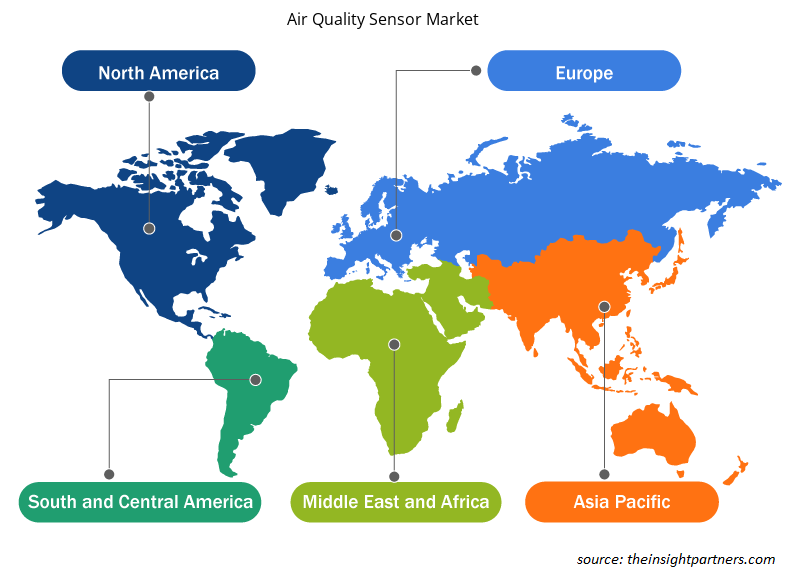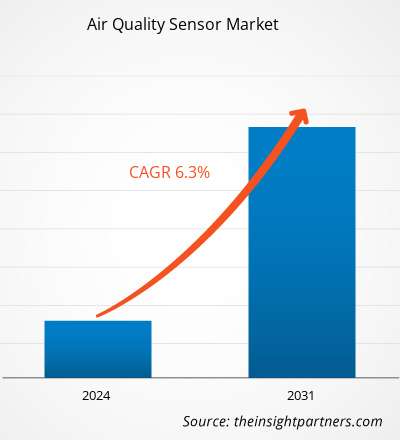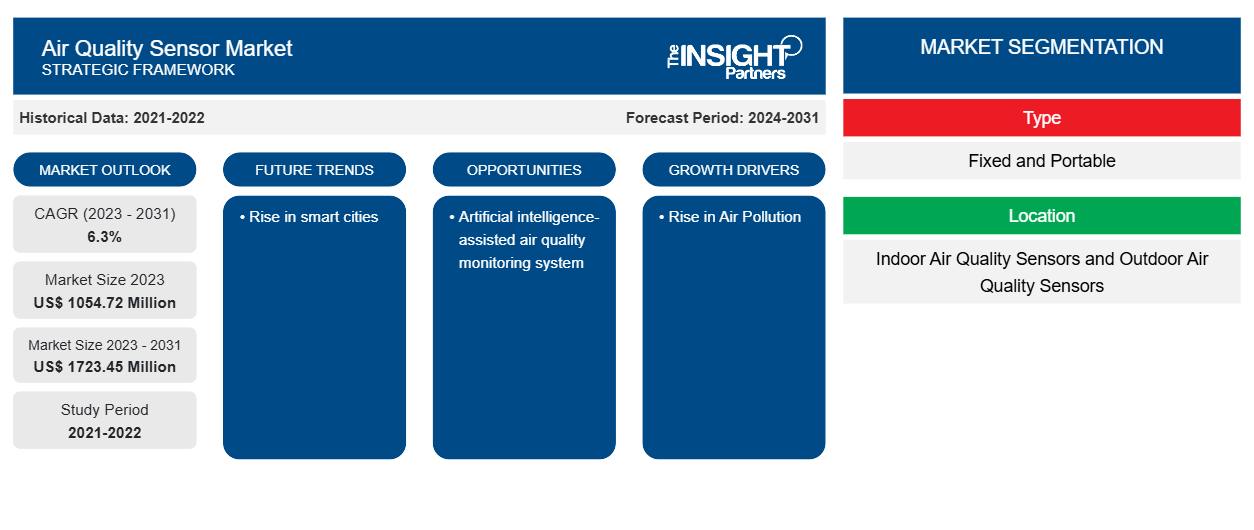Si prevede che la dimensione del mercato dei sensori della qualità dell'aria raggiungerà 1.723,45 milioni di dollari entro il 2031, rispetto ai 1.054,72 milioni di dollari del 2023. Si prevede che il mercato registrerà un CAGR del 6,3% nel 2023-2031. L'aumento dell'inquinamento atmosferico e l'attenzione del governo sulla sostenibilità rimarranno probabilmente le principali tendenze del mercato dei sensori della qualità dell'aria.
Analisi di mercato dei sensori di qualità dell'aria
Le crescenti preoccupazioni ambientali e le severe normative del governo per monitorare la qualità dell'aria stanno portando all'adozione del mercato dei sensori di qualità dell'aria. La crescente consapevolezza riguardo all'importanza dell'aria pulita e agli svantaggi delle malattie trasmesse per via aerea ne alimenta l'adozione in vari settori. Le iniziative governative verso lo sviluppo di settori eco-compatibili ne favoriscono ulteriormente la crescita di mercato.
Panoramica del mercato dei sensori di qualità dell'aria
Un sensore della qualità dell'aria è un dispositivo che misura la concentrazione di inquinanti nell'aria. È un componente essenziale del purificatore d'aria e del sistema di aria fresca. I sensori della qualità dell'aria possono solitamente misurare il particolato (come pm1, pm2,5 e pm10), i gas (come ozono, monossido di carbonio, anidride carbonica, metano, formaldeide e altri) e alcuni indicatori ambientali (come temperatura, umidità, UV, illuminazione e così via). Il sensore della qualità dell'aria rileva indicatori di gas e particolato nell'aria utilizzando metodi ottici, elettrici, termici e altri.
Personalizza questo report in base alle tue esigenze
Riceverai la personalizzazione gratuita di qualsiasi report, comprese parti di questo report, o analisi a livello nazionale, pacchetto dati Excel, oltre a usufruire di grandi offerte e sconti per start-up e università
- Scopri le principali tendenze di mercato in questo rapporto.Questo campione GRATUITO includerà analisi di dati che spaziano dalle tendenze di mercato alle stime e alle previsioni.
Driver e opportunità del mercato dei sensori di qualità dell'aria
L'aumento dell'inquinamento atmosferico favorisce il mercato
L'inquinamento atmosferico è aumentato insieme all'aggiunta di tossine come il particolato dovuto alla crescente industrializzazione. I governi di diversi paesi hanno implementato severe normative nelle rispettive aree e ideato diverse misure per mitigare l'inquinamento atmosferico proveniente da siti industriali. Inoltre, i governi di diversi paesi, tra cui Stati Uniti, India e Canada, installano sensori della qualità dell'aria in centrali elettriche, petrolifere e del gas e automobili per gestire e tracciare i livelli di inquinamento. Utilizzando il monitoraggio della qualità dell'aria esterna, le fabbriche possono controllare i loro tassi di emissione tenendo d'occhio l'indice di qualità dell'aria attorno alle loro unità industriali.
Vantaggi dei sensori della qualità dell'aria
Con le crescenti preoccupazioni ambientali in tutto il mondo, c'è la necessità di monitorare costantemente la qualità dell'aria per adottare determinate misure per minimizzare i suoi effetti sull'ambiente. Pertanto, la domanda di tecnologie di rilevamento della qualità dell'aria sta guadagnando terreno grazie ai diversi vantaggi che offrono. Aiuta a creare un ambiente sano monitorando le condizioni dell'aria interna/esterna in tempo reale. I sensori della qualità dell'aria sono facili da installare e si collegano facilmente al cellulare e al computer dove visualizzano i risultati della qualità dell'aria. Possono rilevare un'ampia gamma di parametri come temperatura, pressione dell'aria, umidità e altro ancora. Con i continui progressi tecnologici, la precisione di questi sensori sta migliorando, portando alla sua richiesta da parte di diversi attori in ampi settori come agenzie governative e istituti accademici, utenti commerciali e residenziali, industria petrolchimica, impianti di produzione di energia , industria farmaceutica, autorità delle città intelligenti e altri. Pertanto, per soddisfare questa domanda, gli attori del mercato lanciano soluzioni che guidano il mercato dei sensori della qualità dell'aria. Ad esempio, a giugno 2021, Vaisala ha lanciato un sensore della qualità dell'aria di livello mondiale che integra la sua soluzione di monitoraggio per migliorare la qualità della vita, la sicurezza, l'efficienza e la sostenibilità nelle comunità.Vaisala launched a world-class air quality sensor complementing its monitoring solution to enhance quality of life, safety, efficiency, and sustainability in communities.
Analisi della segmentazione del rapporto di mercato dei sensori di qualità dell'aria
I segmenti chiave che hanno contribuito alla derivazione dell'analisi di mercato dei sensori della qualità dell'aria sono tipologia, ubicazione e utente finale.
- In base al tipo, il mercato è segmentato in fisso e portatile. Il segmento aeroportuale fisso ha detenuto una quota di mercato maggiore nel 2023.
- In base alla posizione, il mercato è segmentato in sensori di qualità dell'aria interna e sensori di qualità dell'aria esterna. Il segmento dei sensori di qualità dell'aria esterna ha detenuto la quota maggiore del mercato nel 2023.
- In base all'utente finale, il mercato è segmentato in agenzie governative e istituti accademici, utenti commerciali e residenziali, industria petrolchimica, impianti di produzione di energia, industria farmaceutica, autorità delle smart city e altri. Il segmento delle agenzie governative e degli istituti accademici ha detenuto la quota maggiore del mercato nel 2023.
Analisi della quota di mercato dei sensori di qualità dell'aria per area geografica
L'ambito geografico del rapporto di mercato sui sensori della qualità dell'aria è suddiviso principalmente in cinque regioni: Nord America, Asia Pacifico, Europa, Medio Oriente e Africa e Sud America/Sud e Centro America.
In termini di fatturato, l'Asia Pacifica ha rappresentato la quota di mercato più grande per i sensori della qualità dell'aria nel 2023. La regione è composta da economie sviluppate e in via di sviluppo come India, Giappone, Cina e altre, il che sta guidando la domanda di questi sensori per alimentare un ambiente pulito e sicuro. La crescente consapevolezza riguardo ai vantaggi dell'utilizzo di questi sensori alimenta la crescita del suo mercato. Inoltre, gli enti governativi nella regione si stanno concentrando sullo sviluppo di questi sensori, che favoriscono ulteriormente la crescita del suo mercato. Ad esempio, a gennaio 2023, MeitY ha lanciato la tecnologia per il sistema di monitoraggio della qualità dell'aria (AI-AQMS v1.0) sviluppata nell'ambito di progetti supportati da MeitY. Il Centro per lo sviluppo dell'informatica avanzata (C-DAC) di Calcutta, in collaborazione con TeXMIN, ISM, Dhanbad, nell'ambito del "Programma nazionale sulle applicazioni elettroniche e ICT in agricoltura e ambiente (AgriEnIcs)", ha sviluppato una stazione di monitoraggio della qualità dell'aria esterna per monitorare gli inquinanti ambientali, tra cui parametri quali PM 1,0, PM 2,5, PM 10,0, SO2, NO2, CO, O2, temperatura ambiente, umidità relativa ecc., per un'analisi continua della qualità dell'aria nell'ambiente.
Approfondimenti regionali sul mercato dei sensori di qualità dell'aria
Le tendenze regionali e i fattori che influenzano il mercato dei sensori di qualità dell'aria durante il periodo di previsione sono stati ampiamente spiegati dagli analisti di Insight Partners. Questa sezione discute anche i segmenti e la geografia del mercato dei sensori di qualità dell'aria in Nord America, Europa, Asia Pacifico, Medio Oriente e Africa e America meridionale e centrale.

- Ottieni i dati specifici regionali per il mercato dei sensori di qualità dell'aria
Ambito del rapporto di mercato sui sensori di qualità dell'aria
| Attributo del report | Dettagli |
|---|---|
| Dimensioni del mercato nel 2023 | 1054,72 milioni di dollari USA |
| Dimensioni del mercato entro il 2031 | 1723,45 milioni di dollari USA |
| CAGR globale (2023-2031) | 6,3% |
| Dati storici | 2021-2022 |
| Periodo di previsione | 2024-2031 |
| Segmenti coperti | Per tipo
|
| Regioni e Paesi coperti | America del Nord
|
| Leader di mercato e profili aziendali chiave |
|
Densità dei giocatori del mercato dei sensori di qualità dell'aria: comprendere il suo impatto sulle dinamiche aziendali
Il mercato dei sensori di qualità dell'aria sta crescendo rapidamente, spinto dalla crescente domanda degli utenti finali dovuta a fattori quali l'evoluzione delle preferenze dei consumatori, i progressi tecnologici e una maggiore consapevolezza dei vantaggi del prodotto. Con l'aumento della domanda, le aziende stanno ampliando le loro offerte, innovando per soddisfare le esigenze dei consumatori e capitalizzando sulle tendenze emergenti, il che alimenta ulteriormente la crescita del mercato.
La densità degli operatori di mercato si riferisce alla distribuzione di aziende o società che operano in un particolare mercato o settore. Indica quanti concorrenti (operatori di mercato) sono presenti in un dato spazio di mercato in relazione alle sue dimensioni o al valore di mercato totale.
Le principali aziende che operano nel mercato dei sensori di qualità dell'aria sono:
- Energomonitor
- Ho incontrato uno strumento
- SUEZ
- Società di elettronica Renesas
- Vincere
- E+E
Disclaimer : le aziende elencate sopra non sono classificate secondo un ordine particolare.

- Ottieni una panoramica dei principali attori del mercato dei sensori di qualità dell'aria
Notizie di mercato e sviluppi recenti sui sensori di qualità dell'aria
Il mercato dei sensori di qualità dell'aria viene valutato raccogliendo dati qualitativi e quantitativi dopo la ricerca primaria e secondaria, che include importanti pubblicazioni aziendali, dati associativi e database. Di seguito è riportato un elenco degli sviluppi nel mercato:
- Nel marzo 2024, Vaisala, leader mondiale negli strumenti di misurazione e nell'intelligence per l'azione per il clima, ha annunciato il lancio dell'Air Quality Transmitter 560 (AQT560), il sensore compatto di qualità dell'aria di riferimento con un'ampia gamma di rilevamento (PM1, PM2,5 e PM10) e un esclusivo sistema di calibrazione e algoritmi che consentono un'accuratezza e un'efficienza di rilevamento senza pari. (Fonte: Vaisala, Inc, comunicato stampa, 2024)
- A gennaio 2024, Attune, leader del settore nelle soluzioni di dati in tempo reale, ha introdotto la sua ultima innovazione con l'Outdoor Air Quality (OAQ) Kit, una piattaforma basata su sensori progettata per monitorare la qualità dell'aria in qualsiasi sito. Sfruttando i sensori di monitoraggio della qualità dell'aria interna certificati UL-2905 riadattati per l'uso all'esterno, l'OAQ Kit offre dati completi su varie minacce per l'aria esterna. La tecnologia multi-sensore plug-and-play rileva inquinanti come temperatura, umidità relativa, composti organici volatili (COV) e particolato (PM), fornendo agli operatori informazioni fondamentali per un processo decisionale proattivo. (Fonte: Attune, comunicato stampa, 2024)
Copertura e risultati del rapporto di mercato sui sensori di qualità dell'aria
Il rapporto "Dimensioni e previsioni del mercato dei sensori di qualità dell'aria (2021-2031)" fornisce un'analisi dettagliata del mercato che copre le seguenti aree:
- Dimensioni e previsioni del mercato a livello globale, regionale e nazionale per tutti i segmenti di mercato chiave coperti dall'ambito
- Dinamiche di mercato come fattori trainanti, vincoli e opportunità chiave
- Principali tendenze future
- Analisi dettagliata delle cinque forze PEST/Porter e SWOT
- Analisi di mercato globale e regionale che copre le principali tendenze di mercato, i principali attori, le normative e gli sviluppi recenti del mercato
- Analisi del panorama industriale e della concorrenza che copre la concentrazione del mercato, l'analisi della mappa di calore, i principali attori e gli sviluppi recenti
- Profili aziendali dettagliati
- Analisi storica (2 anni), anno base, previsione (7 anni) con CAGR
- Analisi PEST e SWOT
- Valore/volume delle dimensioni del mercato - Globale, Regionale, Nazionale
- Industria e panorama competitivo
- Set di dati Excel
Report recenti
Rapporti correlati
Testimonianze
Motivo dell'acquisto
- Processo decisionale informato
- Comprensione delle dinamiche di mercato
- Analisi competitiva
- Analisi dei clienti
- Previsioni di mercato
- Mitigazione del rischio
- Pianificazione strategica
- Giustificazione degli investimenti
- Identificazione dei mercati emergenti
- Miglioramento delle strategie di marketing
- Aumento dell'efficienza operativa
- Allineamento alle tendenze normative























 Ottieni un campione gratuito per - Mercato dei sensori di qualità dell'aria
Ottieni un campione gratuito per - Mercato dei sensori di qualità dell'aria